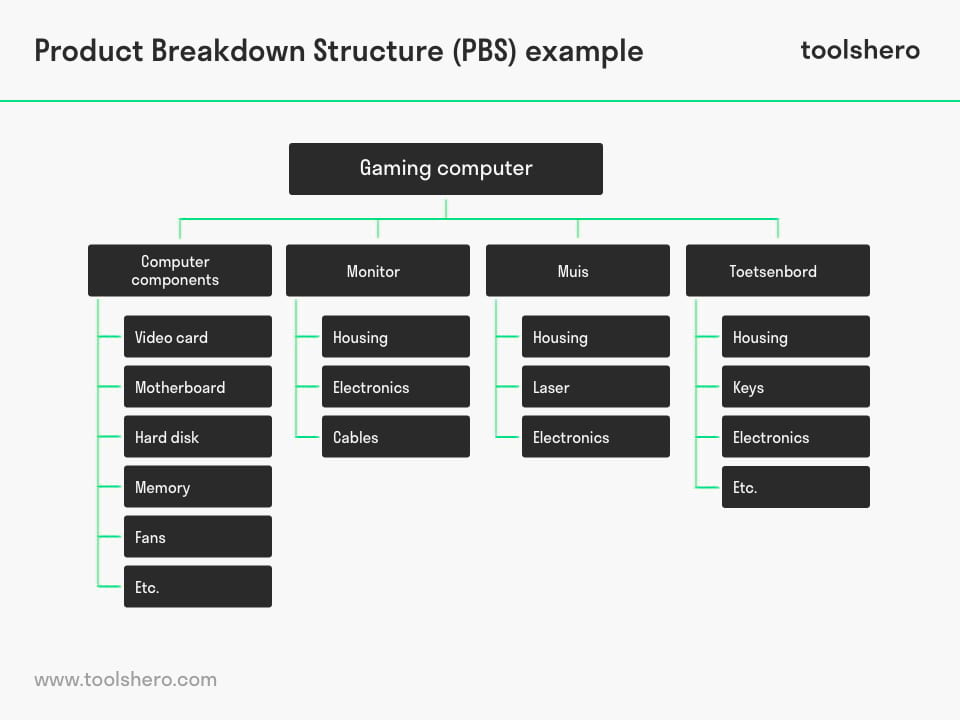Product Breakdown Structure (PBS)

Product Breakdown Structure: this article explains the Product Breakdown Structure (PBS) in a practical way. This article contains a explanation of the PBS, the various steps involved in creating a Product Breakdown Structure, an example and some practical tips. After reading this article, you’ll understand the basics of this project management tool. Enjoy reading!
What is Product Breakdown Structure (PBS)? The theory
The Product Breakdown Structure (PBS) is the hierarchical structure of products and elements that the project requires to succeed, or the results that the project will deliver. It is like a shopping list. The PBS is, in effect, a blueprint, which encompasses all physical components of a particular product or system.
The Product Breakdown Structure (PBS) starts, from the top, with the end product, followed by sub categories with elements linked to the product. The composition of this type of structure is similar to the structure of the Work Breakdown Structure (WBS).
What is the difference between a Product Breakdown Structure (PBS) and a Work Breakdown Structure (WBS)?
As with a WBS, a PBS is an aid to reduce a complex project or final product to manageable components.
Going through these steps will provide teams with a better picture of a product, the components of a product or what will be required to deliver the components. The difference, however, is that a Work Breakdown Structure (WBS) is primarily made up out of activities, similar to a to-do list.
A Product Breakdown Structure (PBS) mainly shows what the project or product consists of, similar to a list of ingredients, or a shopping list.
Why is it important to create a Product Breakdown Structure?
In essence, a PBS splits up the product into various required components. The aim is to create a visual representation of all components, and the relationship between these components. This gives staff working on product planning a clear idea of what will be required to produce the end product.
Example of a Product Breakdown Structure (PBS)
The image below shows a Product Breakdown Structure example of splitting up the required components of a game computer. A PBS provides a clear, complete and hierarchical structure of all deliverable products.

Figure 1 – An Example of a Product Breakdown Structure
Group input is important
Creating a PBS is a group effort and requires information and assessment from a variety of perspectives. An often employed method is to develop a PBS is a brainstorm session.
A brainstorm session is an activity where various team members, representatives and other stakeholders come together to contemplate a particular subject. A product, in this case. Team members collaborate by sharing thoughts through speech, simple materials such as notes, a whiteboard, or similar methods.
Hopefully, plenty of ideas will be generated during the brainstorm session. The ideas are written down on notecards and placed on a wall. They are then placed in order while the team discusses the various components making up the product. The aforementioned activities are also referred to as mind mapping.
The big advantage of brainstorm sessions is that they do not require any technology. It may, however, be a good idea to take the technology approach and switch to an electronic format. There are various tools online which facilitate brainstorming.
How do I create my own Product Breakdown Structure (PBS)? A step-by-step guide
Creating a Product Breakdown Structure requires a number of steps. These are explained below.
Step 1: Build a team
For the most accurate view of all components required for the product, it is important to contemplate the product from various viewpoints. For this reason, putting together a varied team is a crucial aspect. Build the right team, consider the product, and let everyone make a list of all of the components.
Step 2: Consolidate the products into a list
When everyone has shared their own input with everyone else, the individual lists have to be merged. There are various ways of going about this.
Depending on the size of the team, the length of the component list or its complexity, a digital option may be advisable. Much time may be saved by processing this list digitally, particularly for the last step. On the other hand, processing the list manually may unearth new insights while processing.
Step 3: Check the list and remove any duplicates
The component list will likely contain duplicates, seeing how everyone present at the meeting made their own list. Ensure that there is only 1 of each component on the list. Also, check that no mistakes have been made in the list of required components.
Step 4: Evaluate the other products on the list and place them in the appropriate sections
Anything left on the list is the information which will be used to create the Product Breakdown Structure. Evaluate the other products on the list and place them in the appropriate sections. This has been applied to the image above. A product can comprise various parts, which can, in turn, also comprise various parts.
Step 5: Create the Product Breakdown Structure
Once the list has been readied for processing into a visual representation during the previous step, the actual creation of the structure takes place during step 5. As previously mentioned, this can be done both digitally and on paper. To facilitate distribution among the stakeholders, it is advisable to have at least a digital copy of the structure.
Step 6: Test for accuracy
The final step is to test whether the Product Breakdown Structure is actually correct. Decisions may be made about the product’s development based on the PBS. Which makes it paramount that the information on it is absolutely correct.
Use a team to review the PBS and ask yourselves the following questions:
- Does the PBS have a logical structure?
- Does the PBS contain labour components? If so, move this item to the Work Breakdown Structure (WBS)
- Have the parts been split up sufficiently to create adequate levels of detail?
- Have all components been identified, and has the purchase of these been confirmed?
Step 7: Repeat the entire process
Repeat all of the steps, including the accuracy test. Repeat the process until everyone on the team agrees with the design.
The Product Breakdown Structure (PBS) in the Construction industry.
With the ever-increasing competition, businesses are looking for ways to operate more effectively and efficiently. This also goes for the construction industry. In construction, components are often prefabricated. These are required for mass production.
The components are sub-products and are often assembled at a different site. The construction industry allows the human elements of the work to be reduced. An effective PBS can see the replacement of elements of the current composition with more efficient elements.
Flaws of the Product Breakdown Structure (PBS)
While the PBS can be an extremely effective and powerful tool, it does have its limits. Below is the most often cited criticism of the PBS.
Team competencies
The quality of the created PBS is heavily dependent on the competencies of the team to gain clarity about which components are required and available for the product which is to be developed. It is therefore important that the team can avail of a wide spectrum of competencies.
This is necessary to consider a variety of viewpoints. The criticism of PBS also states that it is doubtful that stakeholders will agree to being billed for compiling a team solely for this purpose.
Incomplete
The PBS is exclusively concerned with the end product. The WBS is concerned with the corresponding work. PBS is a project management tool, but it is incomplete.
It must always be used in combination with the WBS, but also with the Organization Breakdown Structure (OBS). This tool was created to clarify the various responsibilities within a project.
Additionally, the PBS only contains those components required to realise the end product, not the products and components required for preparation or for performing any temporary tasks.
Tips for creating the PBS
Keep the following tips in mind while creating the PBS. This will prevent mistakes.
- Define the product and all its related technical requirements
- The item at the very top of the structure must always be the end product
- Do not use more elements in the structure than strictly necessary. This ensures that everything remains clear and factual
- Remember that the PBS is concerned with the end product and not with the amount of labour or the work to be performed.
- Consider giving each element its own colour or name to keep things clear
Additional breakdown structures
To ensure the planning process is shaped in the best way possible, a number of other structures can be created in addition to the PBS and the WBS. Go over these.
Organisational structure
An organisation breakdown structure describes the structure of the organisation that will be delivering the product. This allow for elements from the Work Breakdown Structure (WBS) to be linked to Work Packages for team members.
Cost structure
The cost structure is also linked to the Work Breakdown Structure (WBS). This is a useful link between the project’s finances and the stakeholders’ requirements. Once properly executed, the use of all the breakdown structures will ensure that there will be no surprises during the project or product development.
Risk structure
The risk structure shows where the risks lie, and in which category. This allows the project manager to recognise where the risks are concentrated, in a timely manner. They can then take corrective action to mitigate or delegate the risk. It also helps understand and describe the relationship between various risks.
Resources structure
The resources structure is the hierarchical division of all resources that will be used during the project. This structure is created by the project team and also identifies who is available to work on the project. It also forms the basis for decision-making about matching teams with various Work Packages, as set out in the Work Breakdown Structure (WBS)
Conclusion
The Product Breakdown Structure is an extremely effective tool for splitting up a product, project or service into various components. In itself, the tool details what is required to produce the end product, but its real value emerges when it is used in combination with, for instance, the Work Breakdown Structure and the Organization Breakdown Structure.
Using PBS and WBS when allocating Work Packages can help the project manager to set clear expectations, and to communicate with the stakeholders and project suppliers in a structured way.
Now it’s your turn
What do you think? Do you recognise the explanation of the Product Breakdown Structure (PBS)? Do you include this task in your project plan? Do you see similarities with the Work Breakdown Structure (WBS)? Do you feel that dividing products or work into smaller pieces is effective? Is such a method in operation in your working environment?
Share your experience and knowledge in the comments box below.
More information
- Okayama, Y., & Chirillo, L. D. (1980). Product Work Breakdown Structure. MARITIME ADMINISTRATION WASHINGTON DC.
- Sutrisna, M., Ramanayaka, C. D., & Goulding, J. S. (2018). Developing work breakdown structure matrix for managing offsite construction projects. Architectural engineering and design management, 14(5), 381-397.
- Sigmund, Z., & Radujković, M. (2014). Risk breakdown structure for construction projects on existing buildings. Procedia-Social and Behavioral Sciences, 119, 894-901.
- Turner, J. R., & Downey, A. B. (1993). The handbook of project-based. Management, McGraw-Hill, Boston.
How to cite this article:
Janse, B. (2020). Product Breakdown Structure (PBS). Retrieved [insert date] from Toolshero: https://www.toolshero.com/project-management/product-breakdown-structure/
Original publication date: 03/02/2018 | Last update: 08/12/2023
Add a link to this page on your website:
<a href=”https://www.toolshero.com/project-management/product-breakdown-structure/”> Toolshero: Product Breakdown Structure (PBS)</a>












